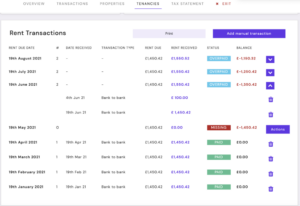
Many of the Government’s Covid-19 temporary measures affecting landlords and tenants’ rights ended on 01 August 2021. These have a considerable impact on what you can and can’t do as a landlord and, specifically, the notice periods you can and can’t serve to your tenants.
Please note: all references to sections refer to the corresponding section of the Housing Act 1988.
One very important point to understand relates to when the agreement was dated and when notice is/was served. In order to protect tenants during unstable times, the Government increased the notice period in most cases to 6 months. This lasted until May 2021 and applies to both Section 8 and Section 21 notices (below). If you served notice prior to the end of May, your tenants are still protected by that 6 month period (e.g. if you served notice at the end of April 2021, you would not be able to take further action until the end of October, if your tenants have not vacated the property). For notices served from 1st June until the end of July, this period was reduced to 4 months. From 1st August, this period was reduced to two months.
In the context of COVID-19, when it comes to rent arrears landlords have been encouraged by the government to resolve disputes between themselves and tenants. Landlords are encouraged to come up with a repayment plan and/or accept lower rent until the tenant is able to pay off the rent arrears.
Hammock’s arrears balance calculator maintains a rolling balance of arrears on a per property and a per tenant basis. Hammock allows landlords to either reach a repayment agreement with the tenant or to write off rent payments that are no longer being collected in full or in part.
Hammock helps landlords keep track of rent payments, alerts landlords immediately where rent is not paid in full on time and allows landlords to send payment reminders to tenants in just two clicks.
From 01 August 2021, when a tenant is less than 4 months behind on their rent payments, landlords can serve a 2 months’ notice to them. If the tenant is 4 or more months behind on their rent, so-called ‘serious arrears,’ this notice period is halved to four weeks.
Try Hammock today
Get started now and enjoy a 30-day free trial
Below is an example of our arrears balance calculator, showing how we keep track of payments and arrears:

This demonstrates how we track payments in full, missing/underpayments and the overall balance of payments.
If no agreement is reached, landlords can usually serve 2 months’ notice as a result of arrears. If a tenant is 4 or more months behind on their rent, this period is halved to 4 weeks.
Yes. The government did enforce notice periods of at least six months to evict tenants during the pandemic, if at all, and bailiffs could not be sent to evict tenants. As of the 1st of August, we have returned to the pre-pandemic rules and landlords can evict their tenants. The notice period and use of bailiffs depends on the specific circumstances, which we explore below.
Bailiffs
Legislation preventing the use of bailiffs expired on 31st May 2021. Therefore, where a landlord has a valid warrant of possession they can now engage bailiffs for evictions or the collection of arrears.
Please note, bailiffs must still provide at least 14 days’ notice of their intention and may not visit a property if they are made aware that anyone living in the property has COVID-19 symptoms or is self-isolating.
No. The rules have changed again in August 2021 and landlords no longer have to give six months’ notice.
Section 8 notices (under the Housing Act) are the most common form of notice served by landlords as they are used in the majority of cases where rental arrears cause the landlord to serve notice.
Section 8 notices were previously protected by the 6 month guarantee during the pandemic. This lapsed on 01 June when the notice period was reduced and reduced again on 01 August.
Section 21 notices, often referred to as ‘no-fault’ notices are so-called because they do not require the landlord to provide a reason for the notice. This form of notice is served when there is no specific issue between the landlord and tenant, including where the landlord wishes to occupy the property, needs to complete maintenance works or where the rental terms are no longer acceptable to the landlord. During the pandemic, the notice period for no-fault notices was also raised to 6 months to protect tenants.
This was reduced from 01 June 2021 to 4 months’ notice and this is still the case after 01 August 2021.
Notices to quit can only be used for certain types of short-term, rolling tenancies and can be served by the landlord or tenant (when served by the tenant this is referred to as “periodic tenancy notice”). All notices to quit must provide at least four weeks’ notice, end on the first or last day of a tenancy period and include legal information, including where to get advice regarding eviction. This cannot be used in the case of Assured Shorthold Tenancies (ASTs), which are the most common form of tenancy (please refer to Sections 8 & 21 above).
In the case of Excluded tenancies, usually where the tenant is a lodger in the landlord’s property, the landlord must only give notice to quit. The length will be the same as the rental payment period – if a tenant pays monthly, reasonable notice is 1 month, though notice cannot be less than four weeks.
In the case of non-excluded tenancies, the notice period will be determined by the rental agreement in place. If none is present, the rental period is likely to be the default.
Protected tenancies are governed by the Rent Act 1977. This includes the majority of tenancies signed before 15 January 1989 and certain tenancies signed after that date if they were signed after that date with the same landlord (even at a different address). This form of tenancy confers the strongest statutory protections available in the UK.
For example, protected tenants cannot be evicted (under any circumstances) unless the landlord has a legal reason that the court agrees is reasonable grounds for eviction. The court must agree before the landlord provides notice to the tenant. From 01 June, for cases where rental arrears are less than 4 months’ rent, the landlord must provide 4 months’ notice before they can apply to court. In cases of ‘serious arrears’ (4 months rent or more), this period is reduced to 4 weeks.
A notice to quit cannot be served to the tenant without the court’s involvement during the fixed term of a protected tenancy unless it is explicitly provided for in the tenancy agreement.
Anti-social behaviour can have a devastating impact on property, other people and the community as a whole and can encompass a wide range of illegal behaviour including domestic abuse. In certain cases landlords may benefit from expedited notice periods where this is for the safety of any person or the property itself.
Due to the increased volume of domestic crimes during the pandemic, the government quite quickly reverted to pre-lockdown notice periods for certain matters. By August 2020, pre-lockdown notice and eviction periods in cases involving anti-social behaviour, domestic abuse and rioting had returned to their pre-lockdown lengths. Subject to the nature of the crime committed and the type of tenancy agreement in place, once legal proceedings have been brought the landlord will have to serve either 2 or 4 weeks’ notice to the tenant(s).
For more information or if you have any questions just hit the chat button in the bottom right corner of your screen or email us at hello@usehammock.com.